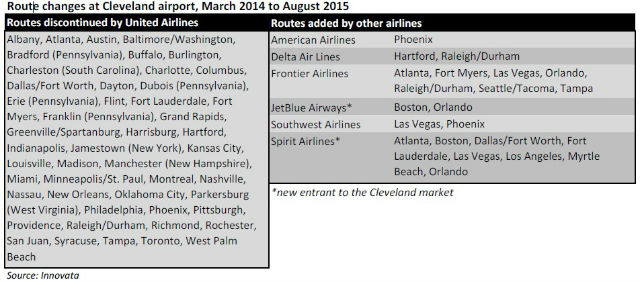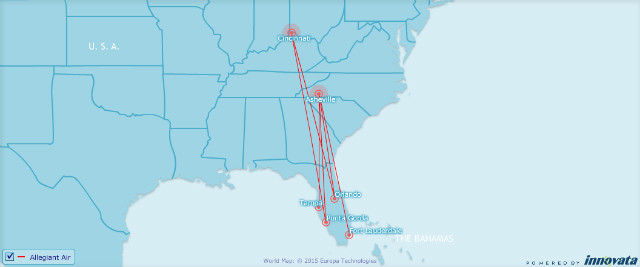Pass through Cleveland Hopkins International airport and you can breeze through security, get a local brew from friendly staff at a pub in the concourse and then sit with a view of idled jet bridges at the shuttered Concourse D.
A former United Airlines hub, the airport saw a significant drop in passenger numbers in the months after the Chicago-based carrier axed many of its routes in 2014. These cuts prompted the closing of concourse D and turned concourse C into a ghost town for much of the day.
Cleveland has quickly turned lemons into lemonade. Frontier Airlines, JetBlue Airways and Spirit Airlines have all added new service to the airport and other mainline carriers have expanded, resulting in an increase in passenger numbers this May compared to last year.
“Consultants tell me that this is the strongest rebound from a dehubbing of any airport,” says Ricky Smith, director of the Cleveland airport. “The rebound has been very strong, the market has been very responsive.”
While up in May, passenger traffic and seat capacity dropped during the first five months of 2015 – albeit at a significantly slower pace than a year ago. Traffic was down 5.9% to 3.1 million and seats were down 2.2%, airport and Capstats data show.

Smith says Cleveland can support nonstop service to 20 of the more than 40 markets eliminated by United. Other carriers have launched service to 19 of these with only Kansas City still lacking service, though he notes that this may change in the coming months.
MIDWESTERN RENAISSANCE
Former hub airports across the US Midwest are in the midst of a renaissance. Low-cost carriers including Allegiant Air, Frontier and Spirit are adding new routes and opening bases in former mid-size cities like Cleveland, Cincinnati and Memphis.
“Mid-size markets have lost over 15% of their seats since 2007 and a lot of that demand is still there,” says Lukas Johnson, vice-president of network and pricing at Allegiant. “There’s some gaps in the market that we think we can serve.”
Cincinnati/Northern Kentucky International airport has become the Las Vegas-based carrier’s fastest growing origination city since it entered the market in February 2014, he says. It now offers 35 weekly flights from the airport to 11 destinations, on both a seasonal and year-round basis.
Allegiant’s expansion in Cincinnati has helped drive the 2.8% increase in passenger traffic and 3.4% increase in seats at the airport during the first five months of 2015, airport data and Capstats show.
The airline recently named Cincinnati as one of its three new mid-continent bases with plans to domicile three Airbus A319s there from January 2016. Asheville Regional and Pittsburgh International airports will house the other two bases.
Allegiant routes from Asheville, Cincinnati, Memphis and Pittsburgh, February 2014

Allegiant routes from Asheville, Cincinnati, Memphis and Pittsburgh, September 2015*

*Seasonal Cincinnati-Austin, Cincinnati-New Orleans and Memphis-Austin service is not shown
Innovata
Allegiant will offer new point-to-point markets in addition to its bread-and-butter leisure routes, for example Las Vegas and Orlando Sanford, from the new bases, says Johnson. Point-to-point routes – like Austin-Memphis and New Orleans-Cincinnati – will often be in markets with no nonstop service and bidirectional traffic, he adds.
Frontier also sees opportunity in mid-size markets.
“We’re looking for growth opportunities outside of Denver that have high yield and high cost combination that we can get access too,” said Barry Biffle, president of the Denver-based carrier, in February. Mid-size markets work for it when it “can pair it with enough other markets”, he added.
In Cincinnati, Frontier has more than tripled the number of seats it offers in the market during the first five months of this year, Capstats shows.
Frontier routes from Cincinnati, Cleveland and Memphis, January 2014

Frontier routes from Cincinnati, Cleveland and Memphis, September 2015

Innovata
LOW BARRIERS
Simply losing a hub is not enough for an airport to land new service or a base from a low-cost carrier. Passenger demand must exist and barriers to entry need to be low to attract them.
“Don’t put up roadblocks,” says Johnson, when asked what airports can do to attract Allegiant. This includes both encouraging travellers to use the new service and making it easy to access terminal and gate space.
Airports take a variety of approaches to this. They range from no incentives in Memphis to start-up cost relief and marketing support in Cleveland and full revenue guarantees in other cities.
“If I’ve got to buy air service, it’s not going to do me or the airline any good when my subsidy runs out,” says Scott Brockman, chief executive of the Memphis International airport. The airport focuses its air service development efforts on cities where it knows there is long-standing local demand, he adds.
Since Delta pulled down the former Northwest Airlines hub in Memphis, Allegiant has added new service to a number of cities in Florida and Las Vegas, American to Philadelphia with New York LaGuardia coming in November and Southwest Airlines to Dallas Love Field.
“We’re trying to build a diverse portfolio of airlines,” says Will Livsey, senior manager of air service research and development in Memphis. “It’s about really trying to fill the void for everybody.”
Cleveland offers incentives to reduce start-up costs and will market new routes in the region, says Smith. However, he also emphasises the need to focus on routes where local demand exists.
“We know Cleveland can be a profitable environment [for airlines], it’s just the cost of mobilising,” he says. “They establish their loyal following in the marketplace and it becomes a lot easier to sustain themselves.”
Frontier continues to operate in markets where the incentives it received from the airport have expired and Spirit is talking about further expansion despite its incentive package expiring in September, says Smith.
No airline is likely to turn down incentives as airports around the country compete for new air service. But they have also proven willing to quickly ax service that is not profitable, with both Allegiant and Frontier willing to pull out of markets before flights even begin.
It all comes down to local demand – figuring out what routes a market can support itself and getting airlines to fly them.
“Rebuilding this service after a closure of a hub, it’s a marathon – not a sprint,” says Brockman. “We’re in this rebuilding Memphis’s hub as opposed to Delta’s hub or Northwest’s hub.”
Source: Cirium Dashboard


























